Click on images to enlarge
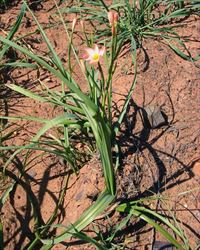
several plants (Photo: Sheldon Navie)
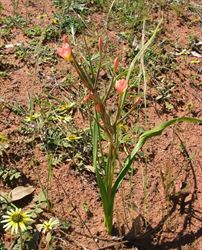
habit showing the two large strap-like leaves (Photo: Sheldon Navie)
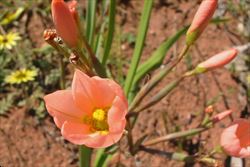
young flowers and flower buds (Photo: Sheldon Navie)
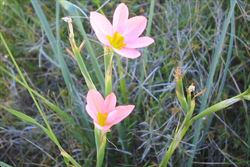
flowers subtended by leafy bracts (Photo: Sheldon Navie)
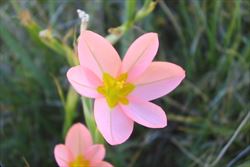
close-up of flower (Photo: Sheldon Navie)

close-up of leaf fork, with cluster of small bulb-like structures (Photo: Sheldon Navie)
Scientific Name
Moraea miniata Andrews
Synonyms
Homeria miniata (Andrews) Sweet
Family
Iridaceae
Common Names
Cape tulip, poison bulb, red tulip, two leaf Cape tulip, two-leaf Cape tulip, two-leaf Cape-tulip, two-leaved Cape tulip
Origin
Native to southern Africa (i.e. Cape Province in South Africa).
Cultivation
Like many other South African bulbous plants with attractive flowers, this species has been widely cultivated as a garden ornamental in the temperate regions of Australia.
Naturalised Distribution
Two-leaf Cape tulip (Moraea miniata) is widely naturalised in southern Australia (i.e. in south-western Western Australia, south-eastern and southern South Australia, Victoria and some parts of eastern and southern New South Wales).
Habitat
A weed of pastures, open woodlands, grasslands, wetland margins, roadsides, parks, disturbed sites, waste areas and crops in temperate and occasionally also semi-arid regions.
Habit
An upright (i.e. erect) herbaceous plant with long-lived (i.e. perennial) underground 'bulbs' (i.e. corms) and short-lived (i.e. annual) stems and leaves. It usually grows 30-60 cm tall.
Distinguishing Features
- an upright herbaceous plant with short-lived stems (30-60 cm tall) and long-lived underground 'bulbs'.
- each plant usually produces two (rarely up to five) large strap-like leaves which sheath the base of the stem.
- large numbers of small bulb-like structures (i.e. cormils) are produced in the forks of these leaves.
- its flowers are usually salmon pink or orange colour, with yellow centres, and have six relatively broad 'petals' (13-25 mm long).
- its fruit is an elongated capsule (up to 15 mm long) that does not produce any viable seeds.
Stems and Leaves
The green stems are upright (i.e. erect) and sometimes slightly zig-zagging in nature. These stems are rounded, hairless (i.e. glabrous), and have a few branches near the top of the plant.
Usually only two, but sometimes three and rarely up to five, leaves are produced per plant. These large strap-like (i.e. linear) leaves (20-100 cm long and 5-15 mm wide) sheath the base of the stem. They are hairless (i.e. glabrous), slightly ribbed, and folded when young. Small bulb-like structures (i.e. cormils) about 2-4 mm long are formed in the forks (i.e. axils) of these leaves after flowering. There are also some smaller green leafy bracts (3-5 cm long) towards the top of the stems.
Flowers and Fruit
The flowers (3-5 cm across) are borne at the ends of the branches and have six relatively broad 'petals' (i.e. tepals or perianth segments) 13-25 mm long. These flowers are usually salmon pink or orange in colour with a yellow centre. At the base of each flower are two elongated green floral bracts (3-6 cm long) which may be mistaken for sepals. Each flower also has three stamens with small yellow anthers (about 2 mm long) and an ovary topped with a three-branched style. Flowering occurs mostly during late winter and early spring (i.e. from August to October).
The fruit is a small green capsule that turns brown in colour as it matures. However, this elongated capsule (about 15 mm long) does not produce any viable seeds.
Reproduction and Dispersal
This species reproduces vegetatively by corms and also produces large numbers of small bulb-like structures (i.e. cormils or bulbils) in the leaf forks (i.e. axils), at the base of the underground corms, and sometimes also at the base of the dying flowers. Mature corms (10-25 mm across) are white with a hard black covering.
These corms are spread by machinery and contaminated agricultural produce and also during the cultivation of paddocks.
Environmental Impact
Two-leaf Cape tulip (Moraea miniata) is regarded as a significant environmental weed in Victoria, South Australia and Western Australia, and was recently listed as a priority environmental weed in at least one Natural Resource Management region.
Other Impacts
Legislation
This species is declared under legislation in the following states and territories:
- New South Wales: Class 4 - a locally controlled weed. The growth and spread of this species must be controlled according to the measures specified in a management plan published by the local control authority and the plant may not be sold, propagated or knowingly distributed (in a minority of local authority areas). See the New South Wales Department of Primary Industries Noxious Weeds List at http://www.dpi.nsw.gov.au for more detailed information on which local areas are covered in these declarations. This declaration includes all Cape tulip species (Moraea spp.).
- South Australia: 2n@ - this species is regarded as a Class 2f weed and its control is required in part of the state only.
- Tasmania: D - the importation or sale of this species is prohibited and measures to reduce its population in an area, eradicate it from an area, or restrict it to a particular area may be required.
- Victoria: P6 - prohibited and must be eradicated or controlled (in the Mallee, Corangamite, Port Phillip East, Goulburn and North East regions and all parts of the Wimmera region except the West Wimmera local authority area), and C3 - all reasonable steps must be taken to control the weed and prevent its spread (in the Glenelg, North Central and Port Phillip West regions and also in the West Wimmera local authority area of the Wimmera region).
- Western Australia: P1 - the movement of this species or its seeds is prohibited (throughout the entire state), P3 - a weed which cannot be eradicated in the short term, but must be kept under 'control' (in some parts of the state), and P4 - it must be 'contained' (in some parts of the state). See the Western Australian Department of Agriculture and Food Declared Plant List at http://www.agric.wa.gov.au/ for more detailed information about which areas are covered by these declarations.
Management
For information on the management of this species see the following resources:
- the Western Australian Department of Agriculture and Food Farmnotes on Cape tulips, which are both available online at http://www.agric.wa.gov.au.
Similar Species
Two-leaf Cape tulip (Moraea miniata) is similar to one-leaf Cape tulip (Moraea flaccida) and two other less common species of Cape tulips (i.e. Moraea collina and Moraea ochroleuca). These species can be distinguished by the following differences:
- two-leaf Cape tulip (Moraea miniata) has two or three large leaves and usually has salmon pink or orange flowers with relatively broad petals (13-25 mm long). It is a relatively large plant, usually 30-60 cm tall, and produces small bulb-like structures (i.e. cormils) in its leaf forks (i.e. axils).
- one-leaf Cape tulip (Moraea flaccida) has a single large leaf and usually has orange or salmon pink (rarely yellow) flowers with elongated petals (30-40 mm long). It is a relatively large plant, often up to 60 cm or more tall, and does not produce small bulb-like structures (i.e. cormils) in its leaf forks (i.e. axils).
- Cape tulip (Moraea collina) has a single large leaf and usually has pale yellow or salmon pink flowers with elongated petals (13-23 mm long). It is a relatively small plant, usually less than 35 cm tall, and does not produce small bulb-like structures (i.e. cormils) in its leaf forks (i.e. axils).
- Cape tulip (Moraea ochroleuca) has a single large leaf and usually has yellow (rarely orange) flowers with relatively broad petals (30-40 mm long). It is a relatively large plant, usually 40-70 cm tall, and does not produce small bulb-like structures (i.e. cormils) in the leaf forks (i.e. axils).

